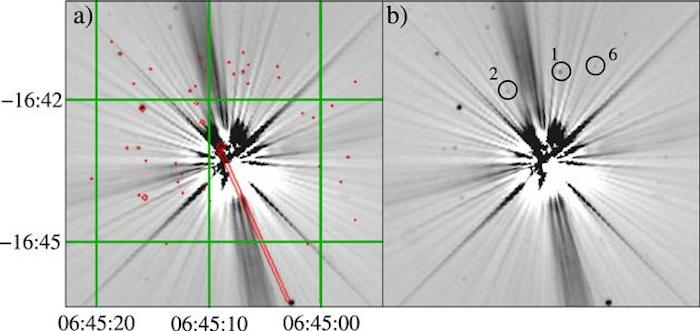.

The CID device has the ability to detect dim objects even behind Sirius, the brightest star in our galaxy. The "A" image shows the Sirius field and the sky coordinates in green. Red dots represent already cataloged objects. The red line is the motion of Sirius. The "B" image shows faint objects detected near Sirius. Image courtesy Florida Institute of Technology.
.
One of the biggest quests in astrophysics is to find Earth-like planets around other stars - places where life may exist. Regular telescopes are not good at directly imaging such small objects because a host star's light generally drowns out the relatively dimmer light of a potential planet. But a new development in space imaging may solve that vexing problem.
A study led by Florida Institute of Technology astrophysicist Daniel Batcheldor has demonstrated that a charge injection device, or CID, has the ability to capture light from objects tens of millions of times fainter than another object in the same picture. An exoplanet next to bright star is one such example. This ability is a result of how the CID is used as a type of camera: each individual pixel works independently and uses a special indexing system. Very bright pixels get addressed very quickly, while the faint pixels are allowed to carry on gathering the fainter light.
"If this technology can be added to future space missions, it may help us make some profound discoveries regarding our place in the universe," Batcheldor said.
The study's findings were reported in the Jan. 18, 2016, edition of the Publications of the Astronomical Society of the Pacific.
To study exoplanets in detail, scientists are forced to make observations of these very faint objects next to bright stars. The situation is often described as the candle-next-to-the-lighthouse problem, though in reality is thousands of times worse. "Current instrument technology is very complex and expensive and still a ways off from achieving direct images of Earth-like planets," Batcheldor said.
With a grant from the American Astronomical Society, Batcheldor and several graduate students in the Physics and Space Sciences Department led the study using a CID on Florida Tech's 0.8-meter Ortega telescope. They were able to pick out objects 70 million times fainter through the glare of Sirius, the brightest star in our night sky. That's over one thousand times better than an off-the-shelf astronomical camera.
The fact that a faint object could be accurately detected through the less-than-ideal, thick Florida atmosphere makes the observations made by the CID more exciting. Batcheldor plans to test the CID later this year at a telescope on the Canary Islands, and a prototype for a CID is slated for testing on the International Space Station later this year. In both cases, the CIDs are being built by Thermo-Fisher Scientific.
Batcheldor's solution is of potential interest to scientists because it is relatively inexpensive compared to other ideas, such as an external occulter like a star shade, which would require multiple, complicated components working in tandem in space for getting a glimpse of just a few small, Earth-sized exoplanets.
"Personally, I like very simple, straightforward solutions, especially when there is a complex problem," he said. "The CID is able to look at a very bright source next to a very faint source and not experience much of the image degradation you would normally experience with a typical camera."
Quelle: SD
4347 Views
